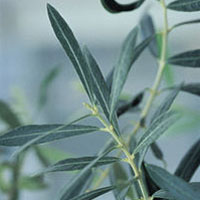Penn Herb Wellness Guide
Olive LeafFind Products
 © Martin Wall
© Martin WallParts Used & Where Grown
Olive is a small evergreen tree native to Mediterranean regions. The characteristic green to blue-black fruit of this tree yields a useful, edible oil. Both the oil and the dried green-grayish colored leaves are used medicinally.1, 2
- Reliable and relatively consistent scientific data showing a substantial health benefit.
- Contradictory, insufficient, or preliminary studies suggesting a health benefit or minimal health benefit.
- For an herb, supported by traditional use but minimal or no scientific evidence. For a supplement,little scientific support.
Our proprietary “Star-Rating” system was developed to help you easily understand the amount of scientific support behind each supplement in relation to a specific health condition. While there is no way to predict whether a vitamin, mineral, or herb will successfully treat or prevent associated health conditions, our unique ratings tell you how well these supplements are understood by the medical community, and whether studies have found them to be effective for other people.
For over a decade, our team has combed through thousands of research articles published in reputable journals. To help you make educated decisions, and to better understand controversial or confusing supplements, our medical experts have digested the science into these three easy-to-follow ratings. We hope this provides you with a helpful resource to make informed decisions towards your health and well-being.
This supplement has been used in connection with the following health conditions:
| Used for | Amount | Why |
|---|---|---|
Hypertension | 1,000 to 1,600 mg of whole olive leaf extract per day | Olive leaf has been found to reduce high blood pressure, and one clinical trial showed it may be as effective as a blood pressure-lowering medication. |
Osteoarthritis | Refer to label instructions | In a double-blind trial, people with osteoarthritis of the knee had a significant improvement in their pain after taking olive leaf extract. |
Infection | Refer to label instructions | Olive leaf is an herb that directly attack microbes. |
Type 1 Diabetes | Refer to label instructions | Olive leaf extracts have been shown to improve blood sugar control in animals with diabetes. |
Type 2 Diabetes | 500 mg of olive leaf extract or three cups of olive leaf tea daily | Preliminary research suggests olive leaf may improve glucose metabolism and have benefits for people with type 2 diabetes. |
Traditional Use (May Not Be Supported by Scientific Studies)
The olive tree has been held in high esteem throughout history. Moses reportedly decreed that men who cultivated the leaf be exempt from serving in the army. The oil is symbolic of purity and goodness, while the olive branch represents peace and prosperity. Winners in the Greek Olympic games were crowned with a wreath of olive leaves.3 Historically, medicinal use of olive leaf has been for treatment of fevers and for the topical treatment of wounds or infection. As a poultice, it was also used by herbalists to treat skin rashes and boils.4
Copyright 2025 TraceGains, Inc. All rights reserved.
Learn more about TraceGains, the company.
The information presented by TraceGains is for informational purposes only. It is based on scientific studies (human, animal, or in vitro), clinical experience, or traditional usage as cited in each article. The results reported may not necessarily occur in all individuals. Self-treatment is not recommended for life-threatening conditions that require medical treatment under a doctor's care. For many of the conditions discussed, treatment with prescription or over the counter medication is also available. Consult your doctor, practitioner, and/or pharmacist for any health problem and before using any supplements or before making any changes in prescribed medications. Information expires December 2025.


